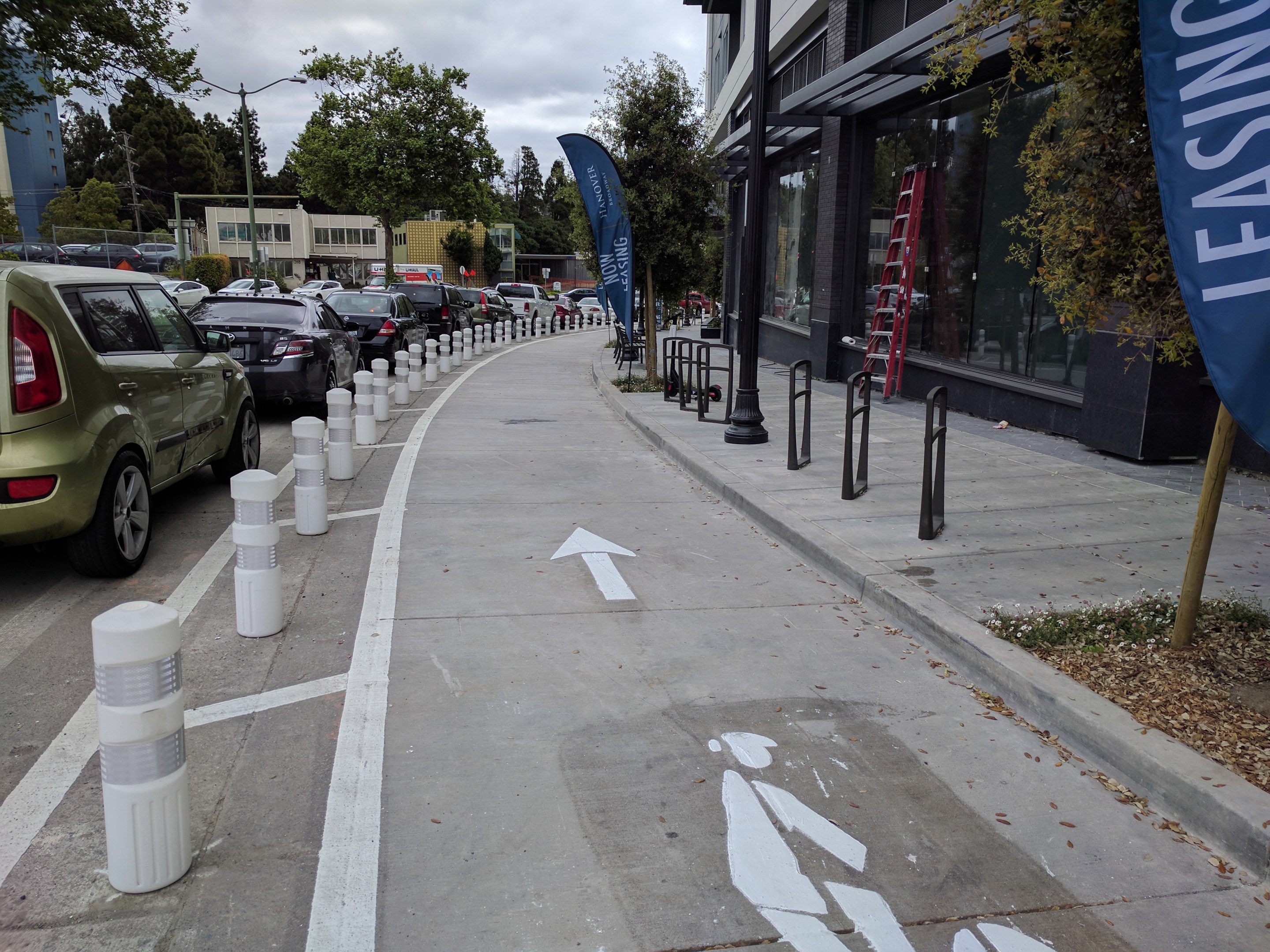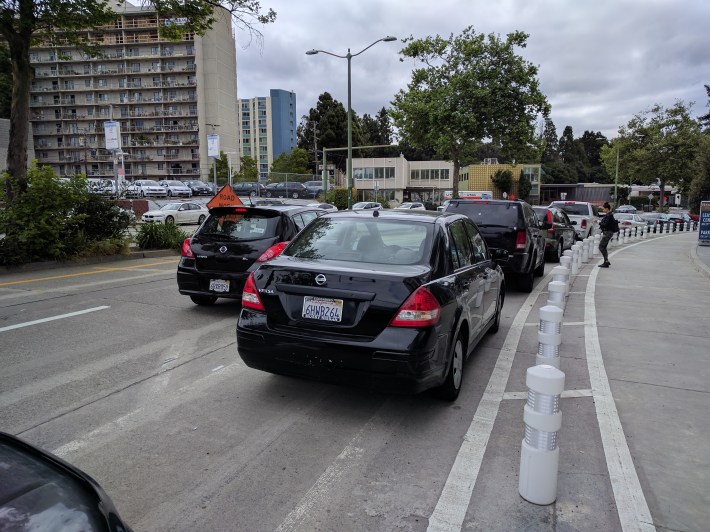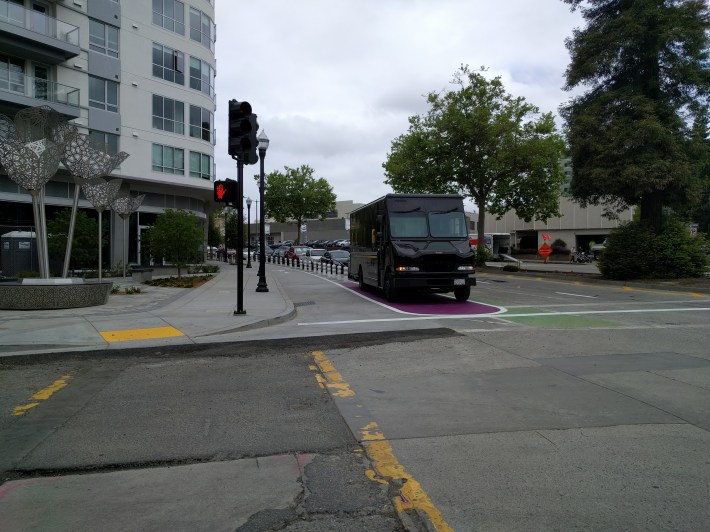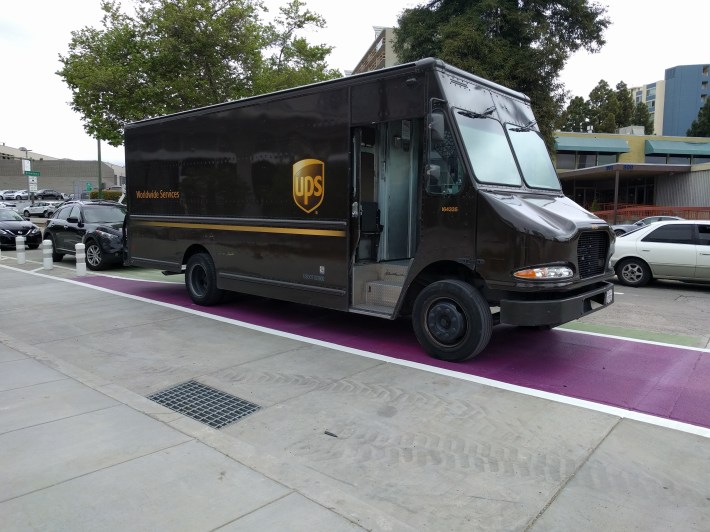Sweet Mitigation: Protected Bike Lanes on 27th
4:38 PM PDT on May 7, 2019

Protected bike infrastructure that resulted from Oakland’s new DOT. Streetsblog/Rudick
Note: GJEL Accident Attorneys regularly sponsors coverage on Streetsblog San Francisco and Streetsblog California. Unless noted in the story, GJEL Accident Attorneys is not consulted for the content or editorial direction of the sponsored content.
A new, protected bike lane is now open on 27th Street in Oakland between Broadway and Valdez. It was constructed by the developer of the adjacent housing project as a mitigation measure. It's just one block long, but it could represent a breakthrough in how protected bike lanes are built and funded.
"As the additional developments down toward Harrison Street are completed, the bikeway will be extended on that side of the street, and OakDOT will do a similar treatment themselves in the other direction. Eventually the 27th Street protected lanes should connect up with additional protected lanes at Harrison and Telegraph on each end," explained Bike East Bay's Robert Prinz.

The new development also includes some nice pedestrian plazas and crossings made safer by eliminating dangerous automobile cut-throughs at Valdez and 27th.

Streetsblog has emails and calls out to the developer, the Hanover Company in Houston, Texas and to the City of Oakland, to find out how much the protected bike lane cost, and will update this post accordingly. Meanwhile, a contact at the city sent us a short email to say "We asked [the developer to build it] and they said yes!"
"It's just paint and plastic, so it shouldn't cost more than about $10,000...developers have never said 'no' when I’ve asked them if they’d build a protected bike lane," said Bike East Bay's David Campbell. "They say, 'I’m happy to do that if OakDOT wants me to do it.'"
Campbell said, as far as he knows, this is the first example in the East Bay of a protected bike lane being funded by developers. A developer in Alameda funded a protected bike lane, but they also had to build an entire street and sidewalk, so it's a little less applicable. In San Francisco, some protected bike lanes have been funded in a general sense as part of city "impact fees" charged to developers, but "as far as I know, there's no one-offs in San Francisco because that's just not how our developer fees work," explained the San Francisco Bicycle Coalition's Janice Li.
As Prinz said, the developer-built bike lane in front of the new building on 27th won't be the end of the story. Hanover is also funding bike lanes on the opposite side of the street, and the development next door, between Valdez and Harrison (which is currently a big hole in the ground), is supposed to do likewise in front of its property.

And another developer-funded bike lane is coming a few miles away, along the Oakland estuary. "The next one is part of the Brooklyn Basin project," added Campbell. "They rebuilt the road there and I think they’re getting ready to open it in June." The Brooklyn Basin project, which will house some 3,000 people, was originally going to have two lanes of car and truck traffic in each direction. Instead, thanks to Bike East Bay's advocacy (and an assist from Streetsblog!) OakDOT asked the developer to turn one lane in each direction into protected bike and scooter infrastructure. "That should be only the second developer-built, protected bike lane," said Campbell.
This is all great news--and more so if it becomes the norm with construction projects. Streetsblog would be remiss, however, not to point out one potentially serious flaw with the protected bike lane on 27th: at the intersection with Valdez, there's a big purple "no parking" zone to increase visibility at the intersection--something that's essential with a parking-protected bike lane, to prevent right hooks. Unfortunately, a UPS driver decided to use it as a parking spot, and I was almost clipped by a truck turning right from 27th onto Valdez. OakDOT or the developer need to put bollards and/or planters in that purple zone to make sure nobody blocks the sightlines, even for a moment.


Campbell said Portland was the first city's he is aware of that started asking developers to fund protected bike lanes next to their projects; Oakland and Bike East Bay learned of this strategy at the last conference of the National Association of City Transportation Officials. Protected bike lanes are cheap--a little more than a rounding error on a multi-million dollar project. Compared with the millions developers have paid to mitigate congestion under the old "Level of Service" regime, developers would be silly to balk at installing some bollards.
Stay in touch
Sign up for our free newsletter
More from Streetsblog San Francisco
Commentary: Making Valencia Better for Business
Curbside protected bike lanes with curbside parklets deliver on much-needed economic benefits for merchants while ensuring safety for all




